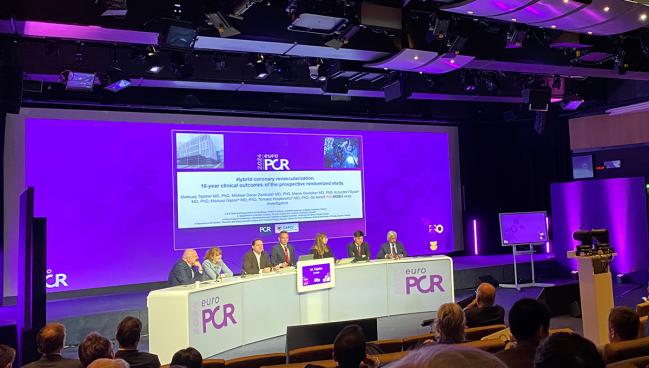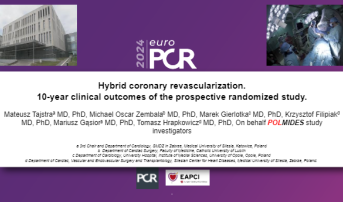POLMIDES: Hybrid Revascularization Bests CABG For 10-Year Survival
The approach, combining PCI and minimally invasive CABG, has never gained steam: can these late data revive the field?

PARIS, France—Patients with multivessel disease randomized to hybrid coronary revascularization (HCR) in the POLMIDES trial are more likely to be alive a decade later than those treated with conventional CABG, new data show.
HCR combines minimally invasive grafting of the left internal mammary artery to the left anterior descending artery and DES implantation elsewhere in the coronary tree, with the aim of fostering a better patient experience as well as enduring long-term patency. The technical expertise and facilities needed to perform it, however, as well as a lack of robust data supporting its safety and efficacy, have proven barriers to wide adoption.
Five-year data from the same trial, which showed comparable outcomes for the two approaches for all-cause mortality as well as MI, repeat revascularization, stroke, and MACCE, left both surgeons and cardiologists hopeful that a hybrid approach might find its niche.
The 10-year results are encouraging for the field, especially given the difficulty HCR trials have had enrolling patients, but experts still agree that they remain hypothesis-generating and that a larger trial, preferably comparing HCR with PCI, would be needed in order to change practice.
“The rationale for the concept of hybrid coronary revascularization [aims] to give the patients the best of these two worlds, the surgical one and percutaneous one,” said Mateusz Tajstra, MD, PhD (Medical University of Silesia, Katowice, Poland), who presented the findings last week at EuroPCR 2024. Despite early support for the combination approach, “the wider implementation of hybrid coronary revascularization in daily practice has not been observed” and guidelines do not recommend it, he noted.
Commenting on the study for TCTMD, Adrian Messerli, MD (University of Kentucky, Lexington), said that, conceptually, HCR is “a really attractive procedure, . . . but we just haven't seen a benefit yet for hybrid over conventional CABG. Certainly at 5 years, we didn't see it. So I think it remains a procedure that's looking for a reason.”
Also, he continued, for HCR to be successful, “you have to have really good collaboration between surgeons and interventional cardiologists. And in many places, that does exist. More often than not, a surgeon will just choose to completely revascularize the heart when they have an opportunity to do so. So there's been reluctance I think to buy in [to] this until you can definitively prove that one strategy is better than the other.”
Similarly, Pedro Moreno, MD (Icahn School of Medicine at Mount Sinai, New York, NY), told TCTMD his personal experience with HCR has been impressive. “I couldn't believe the patients just came out of the OR. They were talking to me, not tachycardic, not anemic, not intubated, very fresh, very nice.”
However, translating these data into practice change will take more, he said. “I want to be a little bit more positive, but unfortunately the data doesn't support it. So far, it's just evolving.”
Similarly, Patrick Myers, MD (Lausanne University Hospital, Switzerland), secretary general of the European Association for Cardio-Thoracic Surgery, told TCTMD the POLMIDES findings are more interesting than actionable. “I don’t think it will shift practice, but it provides some support to doing hybrid coronary revascularization for the those who already do it,” he said in an email. “The findings of the trial, in a relatively small sample, are surprising (or go against what I would expect), and I think we need a larger, multicenter trial to support changing practice.”
POLMIDES at 10 Years
For the study, Tajstra and colleagues followed 200 patients with multivessel disease (mean age 62 years; 24% female) who were randomized to CABG (n = 102) or HCR (n = 98) for 10 years. They reported data for 95.1% and 95.9% of patients in each group, respectively.
At 10 years, fewer patients who underwent HCR compared with CABG had died (20.4% vs 36.3%; P = 0.02). There were comparable rates of MI (13.3% vs 16.7%), coronary reintervention (45.9% vs 51.0%), stroke (5.9% vs 7.1%), and MACCE (56.1% vs 68.6%).
The new data warrant “further validation in multicenter, adequately powered randomized studies to definitively assess the absolute benefits and risks of HCR,” Tajstra said.
Practical challenges remain for HCR as well. First, Tajstra explained, the optimal order in which the procedure is performed remains unclear. During the study, he said, they would often do it in two stages, with PCI being performed a mean 24 hours after the surgery. “But I think the most valuable option is to perform at the same time in the same operating room,” he said, adding that reimbursement is another tricky aspect for HCR given that two distinct teams can participate in each procedure.
Training and surgeon interest also remain challenges. “When you are thinking about a hybrid program, you have to have on board at least one operator dedicated to minimally invasive procedures. Enthusiasm, of course, close cooperation with cardiac surgeons and interventional cardiologists, is required to develop such a program,” he said, adding that younger cardiac surgeons seem to have a growing interest in this space.
Unclear Why Curves Diverge
Messerli pointed out that even though there’s a mortality benefit observed here with HCR, “I don't know that it's going to move the needle.” The curves only deviated at about 8 years, and “I mechanistically have a difficult time explaining why [that] would be attributable solely to hybrid revascularization versus CABG,” he said. “My assumption is that there would be vein graft deterioration at 8 years. It starts to become clinically relevant, but it's difficult to know because there's no real statistical difference in terms of revascularization procedures.”
Myers agreed, noting that it was surprising that HCR was associated with better long-term outcomes given that “the main driver of HCR is to decrease procedural risk in higher-risk patients compared to conventional CABG.” Late dysfunction in the venous conduits could be contributing to this finding, he said, but “these are hypotheses; more granularity on the reasons for late deaths would be useful.”
Messerli said he’s not aware of any centers in the US performing HCR these days but isn’t ruling out the potential for it to be reconsidered. “It's still a very attractive concept,” he said. “If you could, especially with newer drug-eluting stents, prove that this is less harmful to the patient, I think it could absolutely be revived. . . . You’d need an adequately powered trial [with] pretty big enrollment, but I'm not aware of one that's ongoing right now.”
Moreno, who has served as an investigator for the ongoing HYBRID trial comparing HCR and PCI, said the results from that study, though not yet released, aren’t promising. Enrollment difficulties plagued the study, he reported, and “at 5-year follow up, we have not seen . . . dramatic differences in mortality or myocardial infarction.”
However, he said, they have seen advantages regarding time spent in the ICU and in the hospital overall as well as less prolonged intubation use and bleeding with HCR.
In light of all this, at this point, Moreno said the POLMIDES findings have limited power and remain “interesting and hypothesis-generating.”
“It’s definitely not ‘great news’,” he said. “But it shows that if you are less invasive and provide complete revascularization, the patients probably do better than if you are more aggressive.”
Yael L. Maxwell is Senior Medical Journalist for TCTMD and Section Editor of TCTMD's Fellows Forum. She served as the inaugural…
Read Full BioSources
Tajstra M. Hybrid coronary revascularization. 10-year clinical outcomes of the prospective randomized study. Presented at: EuroPCR 2024. May 15, 2024. Paris, France.
Disclosures
- Tajstra, Messerli, and Moreno report no relevant conflicts of interest.





Comments